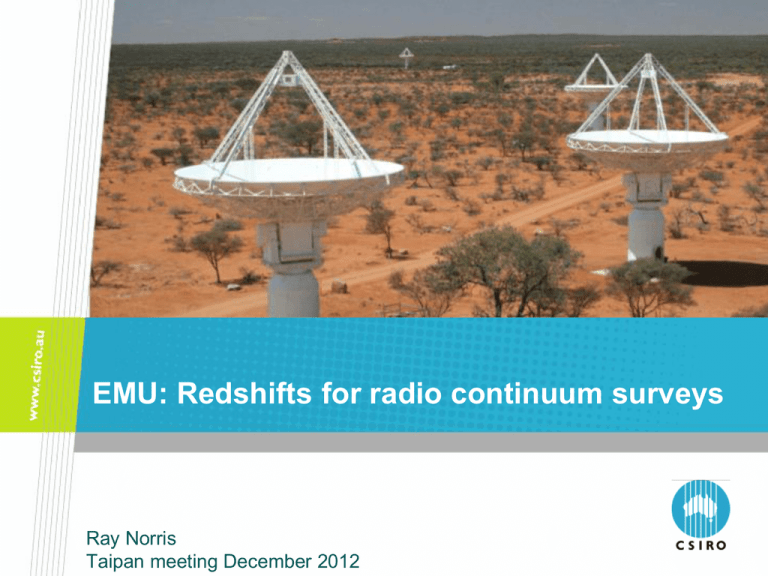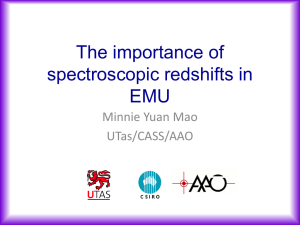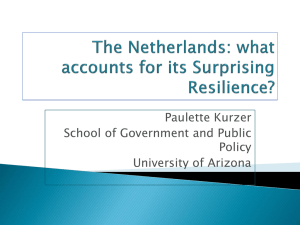EMU: Redshifts for radio continuum surveys
advertisement

EMU: Redshifts for radio continuum surveys Ray Norris Taipan meeting December 2012 Overview • • • • EMU Overview Science Goals Why we need redshifts The EMU redshift project SKA Pathfinders • Pioneer potential SKA technology • Are powerful science-driven observatories • Examples: • ASKAP (Australia) • MWA (Australia) • MeerKAT (South Africa) • LOFAR (Netherlands) • Apertif (Netherlands) • EVLA (USA) • eMERLIN (UK) • eEVN (Europe) ASKAP=Australian SKA Pathfinder • A$170M (=€120m) project now under construction in Western Australia • Completion 2014? • 36*12m antennas • Antennas have a 192-pixel phased array feed (PAF) • 30 sq. deg FOV! This is as significant a step as when optical astronomy migrated from single-pixel photometers to CCD’s. Antennas Antennas built by CETC54 (China) Delivered and assembled on site Antenna 1 delivered late 2009 Phased-Array Feeds (PAFs) ASKAP PAF Aperture Beamformed Receiver Temp (Boresight Beam) Approximate Beamformed Aperture Array Receiver Temperature Trx 295/(y-1) Not Corrected for Sky Brightness Beamformed on Radiated Noise at Boresight ASKAP1 14-Jun-11 ASKAP1 16-Jun-11 5x4 (skunkworks) Single LNA matched to 300 Noise Temperature (K) 200 150 Mk1 PAF 100 Mk2 PAF 50 0 0.6 0.8 1 1.2 1.4 Frequency (GHz) Sensitivity matching conditions: Measurement: unpublished CSIRO - ASKAP SST PI 9 November 2011 1.6 1.8 Hay, IJMOT 5,6,2010 & ICEAA 2010. ASKAP Science 38 proposals submitted to ASKAP 2 selected as being highest priority 8 others at a slightly lower priority • EMU all-sky continuum (PI Norris) • WALLABY all-sky HI (PI Koribalski & Staveley-Smith) • COAST pulsars etc • CRAFT fast variability • DINGO deep HI • FLASH HI absorption • GASKAP Galactic • POSSUM polarisation • VAST slow variability • VLBI Current major 20cm surveys Current major 20cm surveys NVSS 75% of sky rms=450μJy EMU 75% of sky rms=10μJy EMU+WODAN 100% of sky Increasing area Increasing sensitivity • Deep radio image of 75% of the sky (to declination +30°) • Frequency range: 1100-1400 MHz • 40 x deeper than NVSS • 10 μJy rms across the sky • 5 x better resolution than NVSS (10 arcsec) • Better sensitivity to extended structures than NVSS • Will detect and image ~70 million galaxies at 20cm • All data to be processed in pipeline • Images, catalogues, cross-IDs, to be placed in public domain • Survey starts 2014(?) • Total integration time: ~1.5 years ? Redshift distribution of EMU sources <z>=1.1 for SF/SB <z>=1.9 for AGN Based on SKADS (Wilman et al; 2006, 2008) ATLAS=Australia Telescope Large Area Survey Slide courtesy Minnie Mao Science Goals Science Goals 1) Evolution of SF from z=2 to the present day, • using a wavelength unbiased by dust or molecular emission. 2) Evolution of massive black holes • how come they arrived so early? How do binary MBH merge? • what is their relationship to star-formation? 3) Explore the large-scale structure and cosmological parameters of the Universe. • E.g, Independent tests of dark energy models 4) Explore an uncharted region of observational parameter space • almost certainly finding new classes of object. 5) Explore nearby galaxies, clusters, & diffuse low-surface-brightness radio objects 6) Generate an Atlas of the Galactic Plane 7) Create a legacy for surveys at all wavelengths (Herschel, JWST, ALMA, etc) Challenge: difficult to get redshifts, or even optical/IR photometry • Only about 1% of EMU’s 70 million galaxies will have spectroscopic redshifts (mainly from WALLABY, SDSS, and hopefully Taipan). Can’t we just use standard photometric redshifts? •No! • Standard templates do not fit radio sources well • e.g. SWIRE photo-z are90% accurate on most SWIRE sources, but almost indistinguishable from random on radio sources at z>1 • So if we are to use any photometric approach, we need a good training set based on spectroscopy of radio sources that are matched (flux density, z distribution,etc) to EMU sources • -> ATLAS survey (see Minnie Mao talk this afternoon) Diagram courtesy of Minnie Mao F00183-7111 (ULIRG with L=9.1012 Lo) 20kpc z=0.327 1 kpc P=6.1025 W/Hz Merger of two cool spirals: • SB just turned on - AGN just turned on • radio jets already at full luminosity, boring out through the dust/gas • Almost no sign of this at optica/IR wavelengths • see Norris et al. arXiv:1107.3895 What science can we do without redshifts? • E.g Cosmology and GR: • only need to know the redshift distribution of our sample, not the redshifts of individual objects • Use: • Auto-correlation function • Integrated Sachs-Wolfe effrect • Cosmic magnification (weak lensing) Cosmic Magnification Don’t need to know individual z’s, just the z-distribution BUT do need to ensure there is no overlap between samples Dark Energy “Current error ellipse” is based on Amanullah et al., 2010, ApJ, 716, 712, plus Planck data Modified Gravity How do Redshifts Help? All those results made the conservative assumption that no redshifts are available for EMU sources (Raccanelli et al. arXiv 1108.0930) But even imperfect photo-z’s make a big difference (*Camera et al, arXiv 1205.1048) (e.g polarised sources have <z>=1.8, unpolarised sources have <z>=1.1) Implications of statistical redshifts 1) “tomographic cosmology” - EMU samples much larger volume of space than DES etc 2) Further reduce the error ellipses in all above tests So why does EMU need redshifts? • Even cosmology is improved if we have redshifts (e.g. tomographic measurements of dark energy) • And other science goals (e.g. evolution of cosmic SFD and AGN masses) require redshifts of at least a significant subsample. The EMU Redshift WG • Only ~1% of EMU sources will have spectroscopic redshifts (most from WALLABY) • Generating photometric redshifts for AGNs is notoriously unreliable • EMU redshift group (Seymour, Salvato, Zinn, et al) exploring a number of different approaches: • conventional template fitting • kNN algorithms • SoM algorithms • etc kNN does remarkably well! Another alternative approach: Statistical Redshifts Philosophy: Obtain the redshift distribution without necessarily measuring individual z’s 1) Polarisation • • mean redshift of polarised sources ~1.9 mean redshift of unpolarised sources ~1.1 2) Spectral index • Steep spectrum sources have a higher redshift than moderate spectrum sources 3) Radio-k relation • • High values of S20cm/S2.2μm have high z even a non-detection is useful Combining all the above indicators (+others) • Use a Bayesian approach to assign a probabilistic redshift distribution (=> statistical redshifts) So why do we need Taipan? Killer app: • Provide an unprecedented opportunity to measure the local radio luminosity function, on a volume-limited sample of ~105 galaxies with complete radio and spectroscopic information -> relationship between SF and AGN (see Minnie Mao talk) Also: • Measure z’s for the EMU nearby galaxy sample (see Michael Brown talk) • Provide an accurate measurement of z’s for the low-z radio sources to use them as a foreground sample for projects such as cosmic magnification • Eliminate low-z galaxies from our high-z samples (e.g. cosmic magnification) • Obtain spec-z’s for a large number of low-z radio sources to improve our knowledge of templates for photo-z’s Long term: • Make a start on measuring redshifts for all 70 million EMU galaxies! Western Australia








